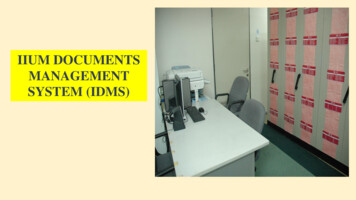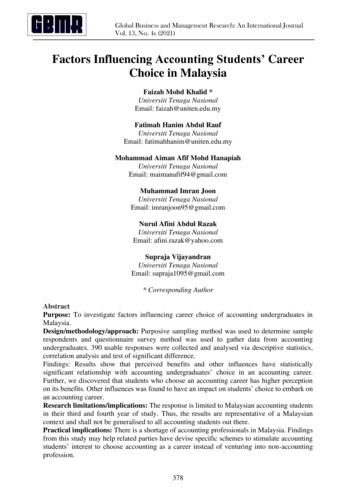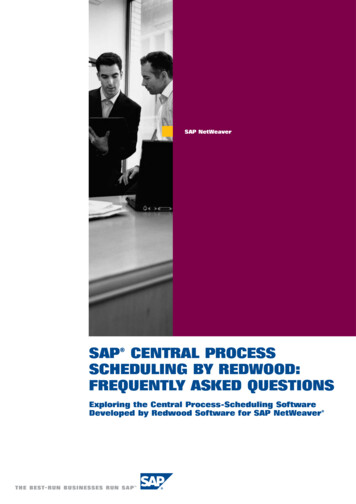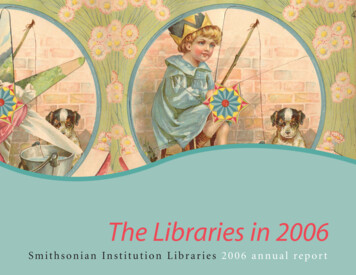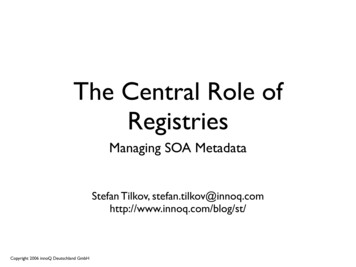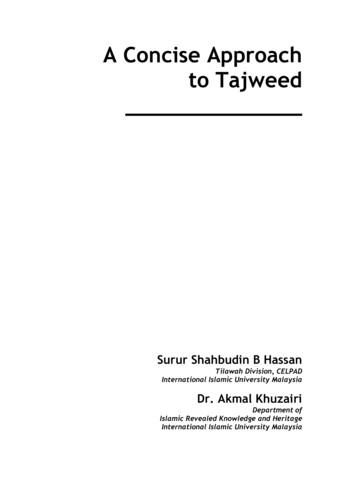
Transcription
A Concise Approachto TajweedSurur Shahbudin B HassanTilawah Division, CELPADInternational Islamic University MalaysiaDr. Akmal KhuzairiDepartment ofIslamic Revealed Knowledge and HeritageInternational Islamic University Malaysia
ContentsAbout the authorsAcknowledgmentsForewordCHAPTER 1: INTRODUCTIONThe Definition of Tajweed1The rules of Tajweed1The advantages of learning Tajweed2The ethics Recitation3Paces of recitation4The Uthmani Script6The different sects and streams of Quranic recitation styles6CHAPTER 2: PLACE AND MANNER OF ARTICULATIONThe organs of speech7Place and manner of articulation in Tajweed9Letters associated with the different places of articulation10CHAPTER 3: THE RULES FOR SAKIN NUUN AND TANWINSakin Nuun and Tanwin12Forms of Sakin Nun and Tanwin13Four Major Rules For Sakin Nun And Tanwin13Idzhar Halqi14Idgham Ma’al Ghunnah & dgham Bila Ghunnah16Idzhar Mutlaq18Iqlab19Ikhfa’ Haqiqi20Exercise23
CHAPTER 4: THE RULES FOR SAKIN MIIMDefinition of Sakin Miim25Idgham Syafawi26Ikhfa’ Syafawi27Izhar Syafawi28Exercise32CHAPTER 5: STRESSED NUUN, STRESSED MIIM, AND NASALISATIONThe stressed Nuun and stressed Miim34The Meaning Of Al-Gunnah (Nasalization)35The Degrees of al-Ghunnah ( ( ) الغُ َّنة Nasalisation)35First, the Musyaddadah (the stressed sounds):36Second, Mudghamah or the assimilated sounds:36Third, Mukhfah or the hidden sounds:37Fourth, Mudzharah or the exposed (made-clear) sounds:37Fifth, Mutaharrikah(the prolonged sounds):38Exercise:39CHAPTER 6: THE RULES FOR MADD ASLIFigure E: Madd Divisions to Hamza and Sukun40Defination of Madd41Madd Tobi’e Categories421. Regular Madd Asli (Mutlaq) ( مد اصلى)مطلق 431.1. Definition of madd asli or madd tobi’e431.2. Terminology431.3. Letters of madd asli431.4. Examples:431.5. The symbols for madd asli:441.6. Rate of Recital:441.7. Exceptions to the madd asli rule - The ziadah letter bearing the symbol ( ) ﹾ 451.8. Madd Tamkin is a Madd Asli451.9. The Jalalah is a Madd Asli46
2. Mad Asli Harfi ( )مد اصلى حرفي 473. Madd ‘Iwadh َم ّد ِع َوض 48(3.1) Definition48(3.2) Examples:48(3.3) Terminology49(3.4) The 6 words in the Qur’an using the ( ) symbol49Cases50ِ4. Madd Silah Sughra صغ َرى ُ َمد صلَة 52(4.1) Definition52(4.2) How it is written52(4.3) How it is read52(4.4) The signs for madd silah sughra53(4.5) Terminology53(4.6) Exceptions54(i.) Ha dhomir found in, Surah al-Furqan, verse 6854(ii.) Ha dhomir found in Surah az-Zumar, verse 754Figure F: Madd Asli Diagram55Exercise56CHAPTER 7: MADD FAR IE AS CAUSE BY HAMZAHThe Meaning of Madd Far‘ie َم ّد َفرِع ّي 57ِ َّ )م ّد مت 1. MADD MUTTASIL ( صل ُ َ57(1.1) Definition57(1.2) Examples57(1.3) The Length of Vowels (harakat)58(1.4) The Naming58(1.5) The Diacritic of Madd Muttasil58(1.6) The Ruling Concerning The Recitation of Madd Muttasil58ِ ) م ّد من َف 2. MADD MUNFASIL ( صل ُ َ59(2.1) Definition59
(2.2) Examples59(2.3) The Length of Harakat60(2.4) The Naming60(2.5) The Diacritic of Madd Munfasil60(2.6) The Ruling Concerning Madd Munfasil60ِ )م ّد 3. MADD SILAH KUBRA ( صلَة ُكب َرى َ61(3.1) Definition61(3.2) Examples61(3.3) The Length of harakat62(3.4) The Naming62(3.5) The Form of Madd Silah Kubra62(3.6) The Ruling Concerning Madd Silah Kubra624. MADD BADAL ( )م ّد َب َدل َ63(4.1) Definition63(4.2) Examples63(4.3) Length of harakat63(4.4) The Recitation rule of Madd Badal63(4.5) The sign of Madd Badal64(4.6) The Naming64Note: Madd Badal at the beginning of recitation (‘ibtida’)64Exercise65CHAPTER 8: MADD FAR IE AS CAUSE BY SUKUN1. MADD ‘ARIDH LIS SUKUN ) (مد عارض للسكون 67(1.1) Definition68(1.2) Examples68(1.3) Length of harakats68(1.4) The Recitation rule68(1.5) The Naming692. MADD LIN (‘ARIDH LIS-SUKUN) ) مد لين (عارض للسكون 69(2.1) Definition69(2.2) Examples70
(2.3) The Length of harakats70(2.4) Recitation Rule70(2.5) The Naming70Types of Madd which are caused by original pause ( )السكون األصلي 711. MADD LAZIM KALIMI MUSAQQAL ( )مد الزم كلمي مثقل 71(1.1) Definition71(1.2) Examples72(1.3) Length of harakats72(1.4) Recitation Rule72(1.5) Identification73(1.6) Naming732. MADD LAZIM KALIMI MUKHAFFAF ( )الزم كلمي مخفف 73(2.1) Definition73(2.2) Examples73(2.3) Length of Harakat73(2.4) Rule of recitation74(2.5) Identification74(2.6) Naming743. MADD LAZIM HARFI MUSAQQAL ( )الزم حرفي مثقل 744. MADD LAZIM HARFI MUKHAFFAF ( )الزم حرفي مخفف 74(a) The definition of Madd Lazim Harfi74(b.) The Categories of Madd Lazim Harfi75(c.) Length of harakats75(d.) Rule of recitation75(e.) Differences between Madd Lazim Harfi Musaqqal and Mukhaffaf75(f.) The Situations of The Letters of The Beginning of Surahs76Example 1: 76 Example 2: in surah al-Syu‘ara’ and al-Qasas.Example 3: 7778
Table of madd types, harakats and examples79Exercise80Conclusion82
Foreword In the name of Allah, Most Gracious, Most Merciful, and Blessings be upon Solawatof Prophet Muhammad s.a.w., his Companions, the Tabiein and those who follow Hisway until the day of Judgement.Thank God, the grace of Allah Almighty, this small research titled Concise Approachto Tajweed can be completed. This study covers the debate about the science ofrecitation to that narrated his reading of the Prophet according Qiraat like AsimImam Hafs narrated by Imam Ash-flow through Syatibiah. It is recommended readingfor those who learn the Quran and is an example of reading most Muslims around theworld. This book has also been prepared to meet the method of writing the KoranResam Uthmani.There are chapters in this study only the things that are important only. Its contentsare just highlighting the basic things that should be known only without lengthydebate. This study is actually a result of the author after many years involved inteaching the science of recitation. In the beginning of this study is in the form of sheetnotes distributed to the students during the author teaches at the International IslamicUniversity Malaysia. The notes are arranged in order to fulfill the requirements of itsinternational students studying in IIUM. Through the study of the Science of Tajweedwritten with English, it is expected this will be used by Muslims all over the worldand be my charity in the afterlife. Aamiin.Surul Shahbudin bin HassanTilawah DivisionInternational Islamic University Malaysia22/3/2012m 29/4/1433h
About the authorsSurul Shahbudin Bin Hassan was born in 1968, in Teluk Intan, Perak. In the earlystages of his studies he was attending school in primary schools Sultan Yusuf, BatuGajah, Perak until 1980. There are studying at Islamic schools Izzuddin Shah, Ipoh,Perak until 1983 and Kolej Islam Klang, Selangor until 1985. He continued hisstudies The Pondok Pasir Tumboh, Kelantan to 1989 before continuing his studies atNadwatul 'Ulama, Lucknow, India in TAHFIZ and Bachelor of Islamic Studies toexpire in 1996. After returning to his homeland has extended the Masters inInternational Islamic University Malaysia (IIUM) in the field of Fiqh and Usul andended in 2000. Now he has completed his studies at the PhD level in the field ofQuranic Education, Faculty of Education at the University of Malaya.Hiking along his studies, he earned a degree two chains Talaqqi andMusyafahah Hafs' an 'Asim of As-Sheikh Muhammad' Abdun nabiy and As-Shaykhal-Bastayisiy Rif'at. He also has a chain Wail al-Hadith Pole Thamaniyah and TariqatQadariyyah degree of As-Shaykh Abu al-Hassan Ali Al-Nadwi (died 1999), the chainJami 'al-Tirmidhi from al-Sheikh Salman Al-Husaini Nadwi and authentic Sanad Al Bukhari of As-Sheikh Mahbub ar-Rahman al-'Azomi.He now serves as a lecturer recitation of the Quran in IIUM and has heldseveral key positions such as Course Coordinator for public recitation (KUTAQ),FLA, CELPAD, Khadamatul Jam'iyyah Advisory Quran (JKQ) and Recital IIUMDivision Chief for the duration of 2000 to 2010.In terms of writing, he has produced a book called "The Science of Tajweed"according to Hafs History 'An' Asim by Tariq Al-Syatibiyyah and another book called"Talaqqi" Basic References Al-Quran. Him letter also recorded the CD reading ofYasin, Tahli and prayer published by Rabbani Production (M) Sdn. Bhd in 2011.
AcknowledgmentsThank God, the grace of Allah Almighty, the concise approach to this Tajweed can becompleted as planned despite the various obstacles in order to prepare it.The author would like to take this opportunity to thank all those who havebeen involved directly or indirectly to this book. Appreciation is created ResearchCentre, IIUM has approved a research grant of up to produce the book.Appreciation also goes to the team of translators who have the language of thisbook into English. I mean they are: Professor Dr. David, who is the Dean of RoszyNon Kulliyyah Langguages and Management (KLM) International Islamic UniversityMalaysia (IIUM), Dr. Zurahani Abdul Rahim from the Department of Bahasa InggerisLanguage & Literature (Dall), IIUM and Dr. Akmal Khuzairi of the Department ofIslamic Revealed Knowledge and Heritage (IRKHS) IIUM.Much appreciation also goes to my teacher Sheikh Andun nabiy (Qiraatteacher at the University of al-Azhar, Egypt), who am I without him in the recitationof the Quran ni. Similarly, the award to the wife who has been with me, to thechildren who will inherit my struggle and parents who have done a lot for me to talkJazakumullahu Khairan Kathir.
FLA, CELPAD, Khadamatul Jam'iyyah Advisory Quran (JKQ) and Recital IIUM Division Chief for the duration of 2000 to 2010. In terms of writing, he has produced a book called "The Science of Tajweed" according to Hafs History 'An' Asim by Tariq Al-Syatibiyyah and another book called "Talaqqi" Basic References Al-Quran.




